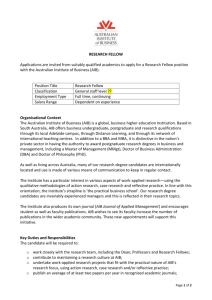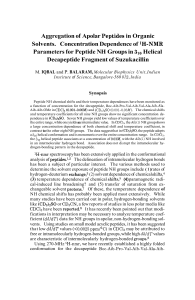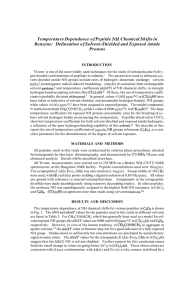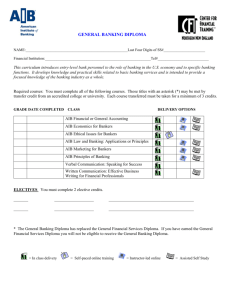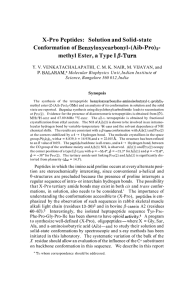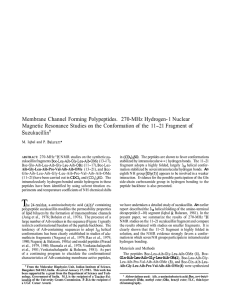of The crystal structure a helical decapeptide containing
advertisement
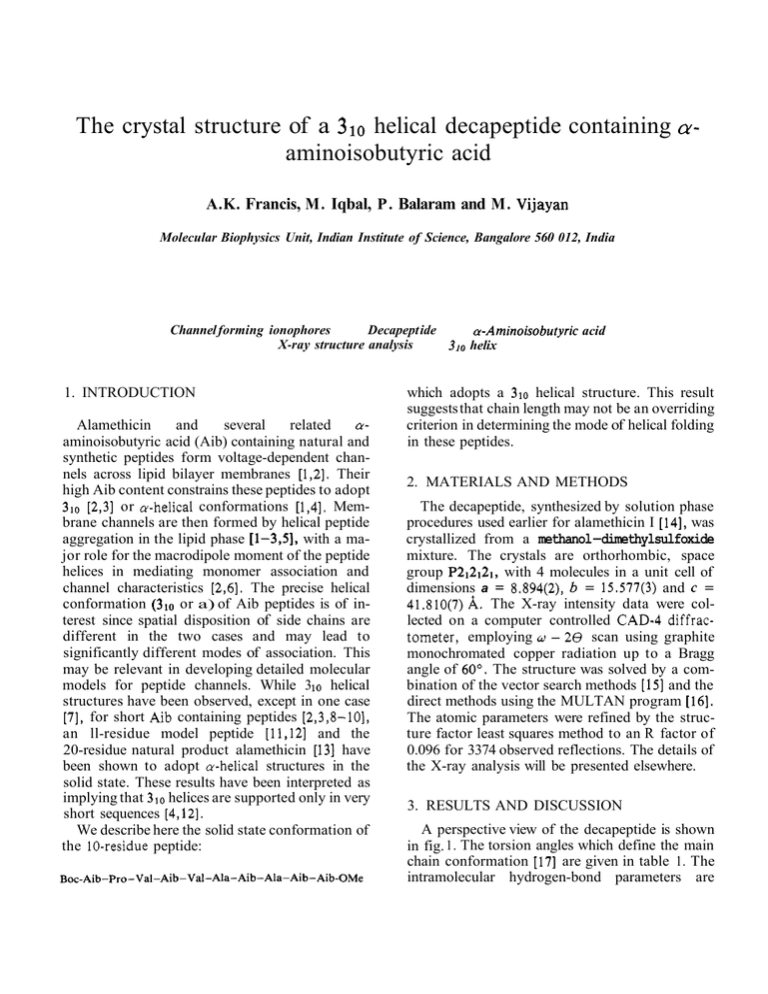
The crystal structure of a 310 helical decapeptide containing aminoisobutyric acid CY- A.K. Francis, M. Iqbal, P. Balaram and M. Vijayan Molecular Biophysics Unit, Indian Institute of Science, Bangalore 560 012, India Channel forming ionophores Decapept ide a-Aminoisobutyric acid X-ray structure analysis 310 helix 1. INTRODUCTION Alamethicin and several related aaminoisobutyric acid (Aib) containing natural and synthetic peptides form voltage-dependent channels across lipid bilayer membranes [ 1,2]. Their high Aib content constrains these peptides to adopt 310 [2,3] or a-helical conformations [ 1,4], Membrane channels are then formed by helical peptide aggregation in the lipid phase [l-331, with a major role for the macrodipole moment of the peptide helices in mediating monomer association and channel characteristics [2,6]. The precise helical conformation (310 or a) of Aib peptides is of interest since spatial disposition of side chains are different in the two cases and may lead to significantly different modes of association. This may be relevant in developing detailed molecular models for peptide channels. While 3 10 helical structures have been observed, except in one case [7], for short Aib containing peptides [2,3,8-101, an ll-residue model peptide [11,12] and the 20-residue natural product alamethicin [ 131 have been shown to adopt a-helical structures in the solid state. These results have been interpreted as implying that 310 helices are supported only in very short sequences [4,12]. We describe here the solid state conformation of the 10-residue peptide: Boc-Aib- Pro-Val- Aib-Val- Ala- Aib- Ala- Aib- Aib-OMe which adopts a 310 helical structure. This result suggests that chain length may not be an overriding criterion in determining the mode of helical folding in these peptides. 2. MATERIALS AND METHODS The decapeptide, synthesized by solution phase procedures used earlier for alamethicin I [14], was crystallized from a methanol-dimethylsulfoxide mixture. The crystals are orthorhombic, space group P212121, with 4 molecules in a unit cell of dimensions a = 8.894(2), b = 15.577(3) and c = 41.810(7) A. The X-ray intensity data were collected on a computer controlled CAD-4 diffractometer, employing (J - 2 8 scan using graphite monochromated copper radiation up to a Bragg angle of 60". The structure was solved by a combination of the vector search methods [15] and the direct methods using the MULTAN program [16]. The atomic parameters were refined by the structure factor least squares method to an R factor of 0.096 for 3374 observed reflections. The details of the X-ray analysis will be presented elsewhere. 3. RESULTS AND DISCUSSION A perspective view of the decapeptide is shown in fig. 1. The torsion angles which define the main chain conformation [17] are given in table 1. The intramolecular hydrogen-bond parameters are Table 2 Intramolecular hydrogen bond parameters in the decapeptide Boc CO - - - HN Val(3) Aib( 1) CO - - -HN Aib(4) Val(3) CO- - - HN Ala(6) Aib(4) CO---HN Aib(7) Val(5) CO- - -HN Ala(8) Ala(6) CO- - -HN Aib(9) Aib(7) CO---HN Aib(l0) @ N A 0 0 Fig. 1. A perspective view of the decapeptide molecule. Table 1 Main chain conformational angles (") in the decapeptide 9 Ic w Aib - 53 Pro - 59 - 35 - 27 - 16 - 34 - 12 - 16 - 33 - 20 - 24 4Oa - 176 - 179 - 178 - 176 Val Aib Val Ala Aib Ala - 70 - 53 -64 - 61 - 50 - 65 Aib - 63 Aib 50 a 175 171 - 177 176 - 179 - 176a y5 and w for the C-terminal residue are defined by assuming that the methoxyl oxygen is stereochemically equivalent to a peptide nitrogen atom 9 3 .OO 15 4 0 3.02 3.13 2.94 3.00 3.11 9 19 12 listed in table 2. The molecule assumes a nearly regular right-handed 310 helical conformation, with #,+ values close to their ideal values of # = - 60°, = - 30'. All the intramolecular 4-1 hydrogen bonds appropriate for a 310 helix are formed, with one exception. The NH group of Val(5) is directed towards the CO group of Pro(2) but the observed N- - -0 separation of 3.46 A is rather large for a good hydrogen bond. We have determined the crystal structure of the amino (residues 1-5) and carboxy (residues 6-10) terminal pentapeptide fragments of the decapeptide. The 1-5 pentapeptide [7] assumes a 4-fold helical conformation, whereas the 6-10 fragment is an almost perfect 310 helix [10,18]. However, in the decapeptide an almost uniform 310 helix is observed over the entire length, although some distortion exists in the amino-terminal half, on account of the increased separation of the Pro(2) CO and Val(5) NH groups. A 310 helical conformation with 8 intramolecular N-H - - - 0 hydrogen bonds, 7 strong and 1 weak, has been established in CDCI3 and (CD3)SO solutions for this decapeptide, from 'H NMR studies [19]. The solid state structure is thus in general agreement with the postulated structure in solution. The decapeptide, whose structure has been described above, corresponds to the aminoterminal sequence originally proposed for the channel forming polypeptide, suzukacillin A [20]. Subsequently this sequence has been revised, by deleting the 2-5 segment of the decapeptide, -Pro-Val-Aib-Val- (G. Jung, personal communication). Nevertheless, the fact that the decapeptide folds into a 310 helix despite the + oc 3.19 presence of 2 Val residues, which have a low preference for helical conformations 1211, demonstrates the high propensity of Aib residues to dictate helical folding. This study also establishes that 3 10 helical conformat~onsmay be favoured even in relatively large oligopeptides, contrary to earlier suggestions that only a-helical structures are iikely to be adopted in peptides longer than 5-6 residues 14,121. However, as mentioned earlier, an 11-residue Aib-containing peptide [1I ,121 and the 20-residue peptide alamethicin [13]fold into a-helices. It would therefore appear that the difference between the propensities of Aib residues for promoting 310 and a-helical conformations in peptides, is marginal. The effect of the proportion and precise positioning of Aib in a given peptide, the role of peptide-peptide interactions and the influence of solvent in the choice between 310 and a-helices are, however, yet to be established. ACKNOWLEDGEMENTS This research was supported by the Department of Science and Technology government of India) and the University Grants Commission (India). We thank Dr K. Suguna and Mr V. Sudhakar for discussions on the vector search method. REFERENCES Jung, G . , Bruckner, H. and Schmitt, H. (1981) in: Structure and Activity of Natural Peptides (Voclter, W. and Weitzel, G . eds) pp.75-114, Walter de Gruyter, Berlin, New York. Mathew, M.K. and Balaram, P. (1983) Mol. Cell Biochem. in press. Nagaraj, R. and Balaram, P. (1981) ACC.Chem. Res. 14, 356-362. [4] Jung, G., Bosch, R., Katz, E., Schmitt, H., Voges, K.P. and Winter, W. (1983) Biopolymers, in press. [S] Iqbal, M. and Balaram, P. (1981) Biochemistry 20, 7278-7285. 161 Boheim, G., Hanke, W. and Jung, 6. (1983) Biophys. Struct. Mech. in press. [7] Francis, A X . , Iqbal, M., Balaram, P. and Vijayan, M. (1982) J. Chem. SOC. Perkin 11, 1235-1239. I81 Benedetti, E., Bavoso, A., Di Blasio, B., Pavone, V., Pedone, C., Crisma, M., Bonora, G.M. and Toniolo, C. (1982) J. Am. Chem. SOC. 104, 2437-2444. [9] Benedetti, E., Bavoso, A., Di Blasio, B., Pavone, V., Pedone, C., Toniolo, C. and Bonora, G.M. (1982) Proc. Natl. Acad. Sci. USA 79, 7951-7954. [ 101 Francis, A.K., Pulla Rao, Ch., Iqbal, M., Nagaraj, R., Vijayan, M. and Balaram, P. (1982) Biochem. Biophys. Res. Commhn. 106, 1240-1247. [ l l ] Butters, T., Hulter, P., Jung, G., Pauls, N., Schmitt, H., Sheldrick, G.M. and Winter, W. (1981) Angew. Chem. Int. Ed. Engl. 20, 889-890. [12] Schmitt, H., Winter, W., Bosch, R. and Jung, G. (1982) Liebigs Ann. Chem. 1304-1321. [13] Fox, R.0, jr and Richards, F.M. (1982) Nature 300, 325-330. [141 Nagaraj, R. and Balaram, P. (19811 Tetrahedron 37, 1263-1270. 1151 Nordman, C.E. (1980) in: Computing in Crystallography (Diamond, R. et al. eds) pp.5.01-5.04, The Indian Academy of Sciences, Bangalore. [16] Cermain, G., Main, P. and Woolfson, M.M. (1971) Acta Crystallogr. A27, 368-376. [17] IUPAC-IUB Commission on Biochemical Nomenclature (1970) Biochemistry 8, 3471-3479. [18] Francis, A.K., Iqbal, M., Balaram, P. and Vijayan, M. (1983) Biopo~ymers,in press. 1191 Iqbal, M. and Balaram, P. (1981) J. Am. Chem. SOC. 103, 5548-5552. [20] Jung, C., Konig, W.A., Liebfritz, D., Ooka, T., Janko, K. and Boheim, G. (1976) Biochim. Biophys. Acta 433, 164-181. tZl] Chou, P.Y. and Fasman, G.D. (1978) Annu. Rev. Biochem. 47, 251-276.

